Related Research Articles
Aden Derek Ridgeway is a Australian former politician. He was a member of the Australian Senate for New South Wales from 1999 to 2005, representing the Australian Democrats. During his term he was the only Aboriginal member of the Australian Parliament. He is currently a spokesperson for Recognise, the movement to recognise Aboriginal and Torres Strait peoples in the Australian Constitution.
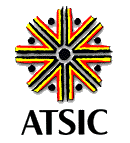
The Aboriginal and Torres Strait Islander Commission (ATSIC) (1990–2005) was the Australian Government body through which Aboriginal Australians and Torres Strait Islanders were formally involved in the processes of government affecting their lives, established under the Hawke government in 1990. A number of Indigenous programs and organisations fell under the overall umbrella of ATSIC.

The Australian Aboriginal Flag represents Aboriginal Australians. It is one of the officially proclaimed flags of Australia, and holds special legal and political status. It is often flown together with the national flag and with the Torres Strait Islander Flag, which is also an officially proclaimed flag.
Galarrwuy Yunupingu, also known as James Galarrwuy Yunupingu, is a leader in the Aboriginal Australian community, and has been involved in the fight for Indigenous land rights in Australia throughout his career. He is a Yolngu man of the Gumatj clan, from Arnhem Land in the Northern Territory. He was the 1978 Australian of the Year.
Reconciliation Australia is a non-government, not-for-profit foundation established in January 2001 to promote a continuing national focus for reconciliation between Indigenous and non-Indigenous Australians. It was established by the Council for Aboriginal Reconciliation (CAR) and subsequently superseded that body in 2001. It organises National Reconciliation Week each year.
Marcia Lynne Langton is the Redmond Barry Distinguished Professor at the Melbourne School of Population and Global Health, University of Melbourne. In 2016 she became distinguished professor and in 2017, associate provost.
Indigenous Australian self-determination, also known as Aboriginal Australian self-determination, is the power relating to self-governance by Aboriginal and Torres Strait Islander peoples in Australia. It is the right of Aboriginal and Torres Strait Islander peoples to determine their own political status and pursue their own economic, social and cultural interests. Self-determination asserts that Aboriginal and Torres Strait Islander peoples should direct and implement Aboriginal and Torres Strait Islander policy formulation and provision of services. Self-determination encompasses both Aboriginal land rights and self-governance, and may also be supported by a treaty between a government and an Indigenous group in Australia.

National Indigenous Television (NITV) is an Australian free-to-air television channel that broadcasts programming produced and presented largely by Aboriginal and Torres Strait Islander people. It includes the half-hourly nightly NITV News, with programming including other news and current affairs programmes, sports coverage, entertainment for children and adults, films and documentaries covering a range of topics. Its primary audience is Indigenous Australians, but many non-Indigenous people tune in to learn more about the history of and issues affecting the country's First Nations peoples.
Indigenous Australians are people with familial heritage to groups that lived in Australia before British colonisation. They include the Aboriginal and Torres Strait Islander peoples of Australia. The term Aboriginal and Torres Strait Islander peoples or the person's specific cultural group, is often preferred, though the terms First Nations of Australia, First Peoples of Australia and First Australians are also increasingly common.

The National Congress of Australia's First Peoples was the national representative body for Aboriginal and Torres Strait Islander Australians. The Congress was announced in November 2009 and set up as a limited company. Its co-chairs were Dr Jackie Huggins and Rod Little. It was registered as a charity in December 2012, but in June 2019 went into voluntary administration and the co-chairs stood down.
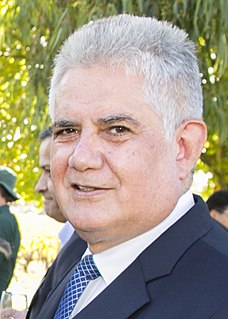
Kenneth George Wyatt is an Australian politician who has been a member of the House of Representatives since 2010, representing the Division of Hasluck for the Liberal Party. He is the first Indigenous Australian elected to the House of Representatives, the first to serve as a government minister, and the first appointed to cabinet. Wyatt was appointed Minister for Aged Care and Minister for Indigenous Health in the Turnbull Government in January 2017, after previously serving as an assistant minister since September 2015. He was elevated to cabinet in May 2019 as Minister for Indigenous Australians in the Morrison Government.
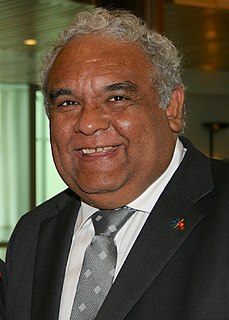
Thomas Edwin Calma,, is an Aboriginal Australian human rights and social justice campaigner. He is the sixth chancellor of the University of Canberra, a post held since January 2014, after two years as deputy chancellor. Calma is the second Aboriginal or Torres Strait Islander person to hold the position of Chancellor of any Australian university.
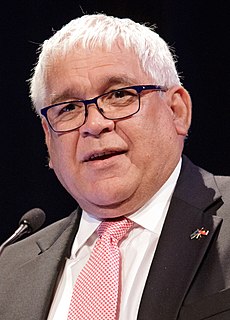
Mick Gooda is an Aboriginal Australian public servant including serving as Aboriginal and Torres Strait Islander Social Justice Commissioner of the Australian Human Rights Commission from 2009 to 2016 and Co-Commissioner of the Royal Commission into the Protection and Detention of Children in the Northern Territory from 2016 to 2017. He is a descendant of the Gangulu people of Central Queensland.
The Closing the Gap framework is an Australian government strategy that aims to reduce disadvantage among Aboriginal and Torres Strait Islander people, based on seven targets. From adoption in 2008, after meetings with the Close the Gap social justice campaign, until 2018, the federal and state and territory governments worked together via the Council of Australian Governments (COAG) on the framework, with the Department of the Prime Minister and Cabinet producing a report at the end of each year analysing progress on each of its seven targets.
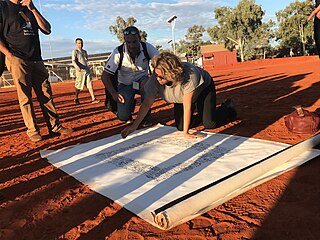
The Uluru Statement from the Heart was released on 26 May 2017 by delegates to the First Nations National Constitutional Convention, held over four days near Uluru in Central Australia. The Convention was held after the 16-member Referendum Council, appointed in 2015, had travelled around the country and met with over 1,200 people. The statement was issued after the Convention, and calls for a "First Nations Voice" in the Australian Constitution and a Makarrata Commission to supervise a process of "agreement-making" and truth-telling between the Australian Government and Aboriginal and Torres Strait Islander peoples.
Pat Turner is an Aboriginal Australian of Gudanji-Arrernte heritage who has worked as a civil administrator for policies which guarantee the right to self-determination for Indigenous people. She was awarded the Order of Australia in 1990 for her service.
Indigenous treaties in Australia describe legal documents defining the relationship between Indigenous Australians and the Government of Australia or the government of an Australian state or territory. As of 2021 there are no such treaties in existence.
Close the Gap (CTG) is a social justice campaign focused on Indigenous Australians' health, in which peak Aboriginal and Torres Strait Islander and non-Indigenous health bodies, NGOs and human rights organisations work together to achieve health equality in Australia. The Campaign was launched in April 2007. National Close the Gap Day (NCTGD) has been held annually since 2009.
Constitutional recognition of Indigenous Australians has been campaigned for since 1910, including having an Indigenous voice to parliament enshrined in the Constitution.
References
- ↑ "The Process". Indigenous Voice. Retrieved 18 July 2020.
- ↑ Parliament of the Commonwealth of Australia. Joint Select Committee on Constitutional Recognition relating to Aboriginal and Torres Strait Islander Peoples (November 2018). Final report. Commonwealth of Australia. ISBN 978-1-74366-926-6 . Retrieved 18 July 2020.
...licensed under the Creative Commons Attribution-Non-Commercial-NoDerivs 3.0 Australia License.
PDF - ↑ "A voice for Indigenous Australians". Ministers Media Centre. 30 October 2019. Retrieved 18 July 2020.
- ↑ Synot, Eddie (30 October 2019). "Ken Wyatt's proposed 'voice to government' marks another failure to hear Indigenous voices". The Conversation. Retrieved 2 February 2020.
- 1 2 Grattan, Michelle (29 October 2019). "Proposed Indigenous 'voice' will be to government rather than to parliament". The Conversation. Retrieved 18 July 2020.
- 1 2 Allam, Lorena (1 February 2020). "Man in the middle: Ken Wyatt on being caught between the Uluru statement and his party". The Guardian. Retrieved 2 February 2020.
- ↑ "Voice Co-Design Senior Advisory Group". Ministers Media Centre. 8 November 2019. Retrieved 24 January 2020.
- ↑ Remeikis, Amy (8 November 2019). "Chris Kenny added to group working on Indigenous voice to parliament". the Guardian. Retrieved 1 February 2020.
- ↑ Wellington, Shahni (13 November 2019). "First meeting held by senior body for Indigenous Voice to government". NITV. Special Broadcasting Service. Retrieved 24 January 2020.
- ↑ Allam, Lorena (28 January 2020). "Josephine Cashman sacked from Indigenous advisory body after letter published by Andrew Bolt". The Guardian. Retrieved 28 January 2020.
- ↑ "Businesswoman ousted from advisory group after Andrew Bolt claim". The Sydney Morning Herald. 28 January 2020. Retrieved 28 January 2020.
- ↑ "Letter revealed to contain paragraphs lifted from academic papers and websites". NITV. 28 January 2020. Retrieved 28 January 2020.
- ↑ "Indigenous Voice". Senior Advisory Group. Retrieved 18 July 2020.
- ↑ "National Co-design Group". Indigenous Voice. Retrieved 18 July 2020.
- ↑ Fryer, Brooke (4 March 2020). "Newly announced advisory body tasked with giving communities a voice". NITV. Retrieved 18 July 2020.
- ↑ "Indigenous voice Local and Regional Co-Design Group announced". National Indigenous Australians Agency. 4 March 2020. Retrieved 18 July 2020.
- ↑ "First Meeting of the Local & Regional Co-Design Group". National Indigenous Australians Agency. 19 March 2020. Retrieved 18 July 2020.
- ↑ "Our People - The Uluru Statement". From The Heart. 15 March 2020. Retrieved 2 September 2020.
- ↑ Wellington, Shahni (15 July 2020). "'Hugely encouraging': Voice to Parliament advocates boosted by poll". NITV. Retrieved 2 September 2020.
- ↑ "Poll Shows Strong Rise in Support for Constitutional Change to Create Indigenous Voice to Parliament". From The Heart. 15 July 2020. Retrieved 2 September 2020.
- ↑ Doran, Matthew (15 November 2020). "Minister Ken Wyatt wants Indigenous voice to government to pass Parliament before next election". ABC News. Australian Broadcasting Corporation. Retrieved 13 December 2020.
- ↑ "Indigenous voice to parliament to have no veto power under interim plans". The Guardian . 9 January 2021. Retrieved 10 January 2021.
- ↑ "Indigenous Voice to parliament will get no veto power under interim proposal". SBS News. 9 January 2021. Retrieved 10 January 2021.
- ↑ Lysaght, Gary-Jon (24 March 2021). "Indigenous Voice to Parliament to include regional voices to address local issues". ABC News. Australian Broadcasting Corporation. Retrieved 27 March 2021.